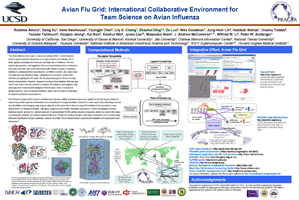 |
||||||||
 |
 |
 |
 |
 |
| Avian Flu Grid: International Collaborative Environment for Team Science on Avian Influenza | ||
|
The avian influenza virus (subtype H5N1) is
currently becoming the world's largest pandemic threat due to the
high lethality, in birds and increasingly humans , and virulence
of its endemic presence, its increasingly large host reservoir,
and its significant ongoing mutations. The two surface glycoproteins,
hemagglutinin (HA) and neuraminidase (NA) of influenza A virus,
play an important role in the interactions with cellular receptors
containing terminal N-acetyleneuraminic acid (Neu5Ac, or NANA) moieties,
aka, sialic acids (http://en.wikipedia.org/wiki/Sialic_acid).
The approved anti-influenza drugs oseltamivir and zanamivir inhibit
H5N1 activity by targeting the NA active site. However, research
has shown that antigenic drift may result in viral resistance to
the abundant presence of existing NA inhibitors through the retention
of NeuAc
| 
| |
moieties by complex glycan near HA receptor binding
site; and antigenic shift could give rise to new virulent subtypes
of the flu virus. Thus, it is crucial to design novel HA- and NA-targeted
inhibitors, which can be used in combination for optimal prophylaxis
and treatment. Work has been ongoing to apply the Relaxed Complex
(RC) scheme and Molecular Dynamics (MD) simulations on the two target
proteins in the hope of capturing key protein dynamics information
and accounting for receptor flexibility. Research is under way to
take advantage of novel loop flexibilities and changing cavity shapeadjacent
to NA active siteto discover novel NA inhibitors that may work in
a way similar to the HIV integrase inhibitor, raltegravir, inspired
by the RC/MD simulation procedures. Further investigation involves
statistical cluster analysis for rational selection of representative
HA/NA protein structure snapshots, which will be used in the virtual
screening with diverse ligand libraries. Finally, the binding energies
of the high scoring compounds will be re-evaluated and refined by
Molecular Mechanics-Poisson Bolzmann Surface Area (MM-PBSA) approach
for lead optimization. By leveraging the PRAGMA grid and high performance
computing (HPC) resources, the implementation of many state-of-the-art
computational techniques would be expected to greatly facilitate the
drug discovery process and improve the accuracy in the search for
novel avian influenza inhibitors, subsequently generate drug leads
with potentials for further validation and development in biological
assays and experiments. |
||
| • Other Abstracts • | ||